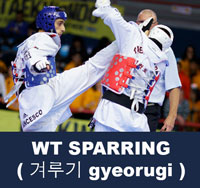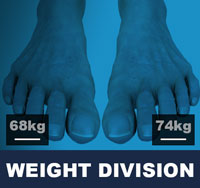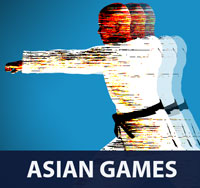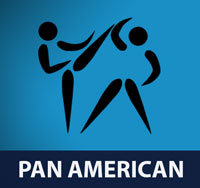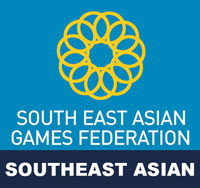Taekwondo 태권도Taekwondo Preschool
In some schools, permission to begin sparring is granted upon entry. The rationale for this decision is that students must learn how to deal with a fast, powerful, and determined attacker. In other schools, students may be required to wait a few months, for safety reasons, because they must first build the skills they would ideally employ in their sparring practice. View Taekwondo Sparring »

Summer Olympic Games
Physically, taekwondo develops strength, speed, balance, flexibility, and stamina. An example of the union of mental and physical discipline is the breaking of wooden boards, bricks or tiles, which requires both physical mastery of the technique and the concentration to focus one's power.
Taekwondo made its first appearance at the Summer Olympic Games as a demonstration sport at the 1988 Summer Olympics in Seoul, South Korea. The opening ceremony featured a mass demonstration of taekwondo with hundreds of adults and children performing moves in unison. Taekwondo was again a demonstration sport at the 1992 Summer Olympics in Barcelona, Spain. There were no demonstration sports at the 1996 Summer Olympics in Atlanta, USA. Taekwondo became a full medal sport at the 2000 Summer Olympics in Sydney, Australia, and has been a sport in the Olympic games since then.
Taekwondo at the 2020 Summer Olympics in Tokyo will feature 128 taekwondo fighters competing in eight weight categories; four for men, and four for women. The 2020 Olympics was postponed to 2021 due to the COVID-19 pandemic.
Taekwondo Summer Olympic Games |
|||||
| Year | Date | Flag | City | ||
| 2028 | XXXII | TBA |  |
Los Angeles | |
| 2024 | XXXIII | August 7 - August 10 |  |
Paris | |
| 2020 | XXXII | July 24 - July 27, 2021 (2020 Postponed due to COVID-19 pandemic) |  |
Tokyo | |
| 2016 | XXXI | August 5 - August 21 |  |
Rio de Janeiro | |
| 2012 | XXX | July 27 - August 12 |  |
London | |
| 2008 | XXIX | August 8 - August 24 |  |
Beijing | |
| 2004 | XXVIII | August 13 - August 29 |  |
Athens | |
| 2000 | XXVII | September 15 - October 1 |  |
Sydney | |
Background to the Olympics
The quest to bring taekwondo to the Olympics began in 1974 when taekwondo was admitted into the Amateur Athletic Union (AAU). One of the AAU's primary roles is to establish standards for various sports nation-wide. The World Taekwondo's technical standards were adopted by the AAU Taekwondo group.
In 1975, taekwondo became an affiliate of the General Association of International Sports Federations (GAISF). The GAISF promotes cooperation among various international sports federations and works closely with the Olympics movement. Five years later, in 1980, the World Taekwondo (WT) was granted recognition by the IOC. The following year, taekwondo was one of the primary events in the World Games, an international competition specifically for non-Olympic events. In 1982, taekwondo was designated an official demonstration sport for the 1988 Olympic Games in Seoul, Korea, and for the 1992 Olympic Games in Barcelona, Spain.
In 1986 and 1987, taekwondo was included in the following international sporting events: World Cup (1986), Asian Games (1986), All-Africa Games (1986), and the Pan American Games (1987). In 1994, the IOC adopted taekwondo as an official Olympic sport for the 2000 Olympic Games in Sydney, Australia.
Olympic Demonstration Sport |
||||
| Year | Date | Flag | City | |
| 1992 | July 25 - August 9 |  |
Barcelona | |
| 1988 | September 17 - October 2 |  |
Seoul | |
Olympic Competition Format
For Olympic competition, there will be a single elimination tournament for each of the weight categories. Repechage competition will occur for the bronze medal contest, while the winner of the tournament will receive the gold medal, and the loser will receive the silver medal. Anyone who loses in the single elimination competition enters the repechage. "In the repechage, the losers of the semifinals during the elimination phase will be seeded directly to each of repechage finals, but on the opposite side of the bracket. Other losers will advance to the repechage unseeded, at the same side of the bracket in which they contested during the elimination phase." The two finalists of the repechage will receive bronze medals. A National Olympic Committee may only send a maximum of two men and two women competitors, without regard whether it is the host nation.
Medals are awarded in four different weight classes for both men and women.
WEIGHT CLASS |
MEN |
WOMEN |
Flyweight |
-58kg | -49kg |
Lightweight |
58kg - 68kg | 49kg - 57kg |
Middleweight |
68kg - 80kg | 57kg - 67kg |
Heavyweight |
+80kg | +67kg |
Risk of injury can be reduced by completing an effective warm up consisting of a heart raiser to get your pulse up, followed by sport specific dynamic stretches (stretches whilst moving). Please follow the guidance of a certified Master Instructor or trainer when doing sports related activities. Depending on the intensity of the exercise, cooling down can involve a slow jog or walk, or with lower intensities, stretching can be used. Cooling down allows the heart rate to return to its resting rate. View more information on Warming Up and Cooling Down ».
This article uses material from the Wikipedia articles "Warming Up" and "Cooling Down", which is released under the Creative Commons Attribution-Share-Alike License 3.0.
RESOURCES
This article uses material from the Wikipedia article "Taekwondo at the Summer Olympics" which is released under the Creative Commons Attribution-Share-Alike License 3.0.


